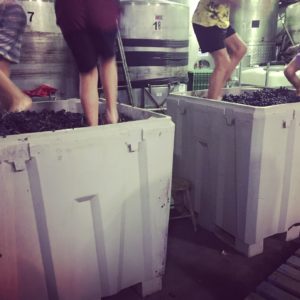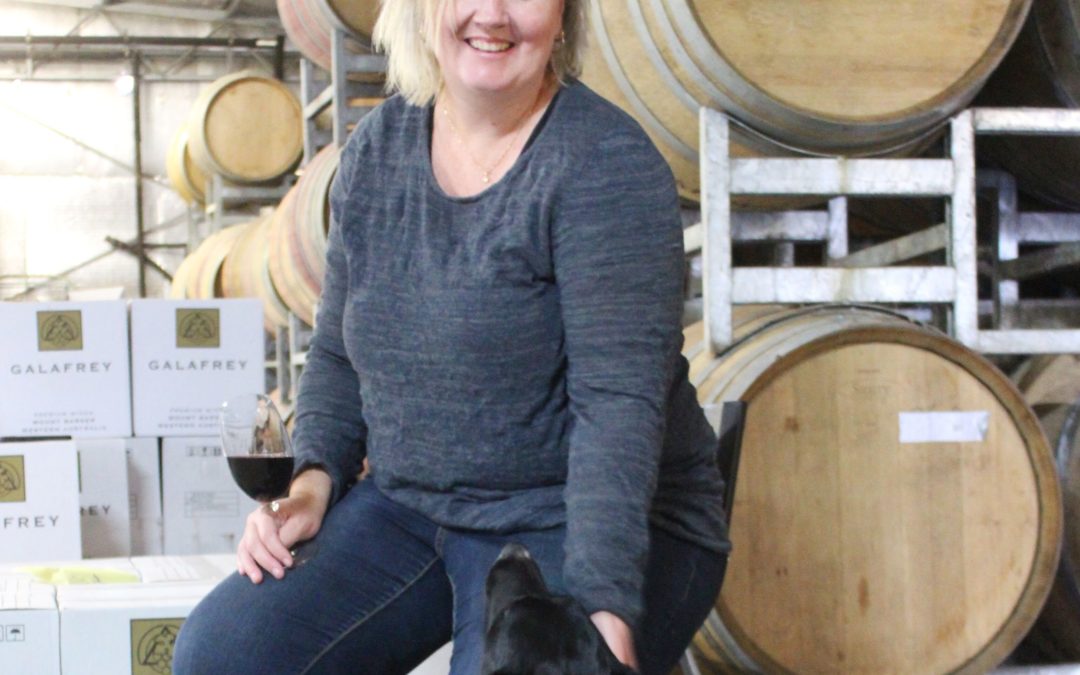Kim Tyrer, CEO and winemaker from Galafrey Wines is taking over our blog today to tell us a little bit about whole bunch fermentation. This is a fascinating process and one that results in truly remarkable wine. You can try Galafrey’s whole bunch wines at their Cellar Door, which is open 10am- 5pm daily (Friday to Monday winter hours). While you’re there, make sure you taste their Riesling, which has been voted one of the top 20 in Australia. They also have an aged range of back vintage of Riesling for those who want something extra special – in the last 4 vintages, 3 have recieved gold medals. Bruce the winery dog will greet you at the car park!

Say hi to wine dog, Bruce!
What the whole bunch?
Ever heard of whole bunch fermentation? The difference is, usually, red wine fermentation involves the grapes being hand-picked or mechanically picked, then put through a crusher destemmer which lightly breaks the skins and removes the stems. The grapes juice is then pumped to an open fermenter where the skins and seeds play a big part in the colour, tannins, and flavour (and of course colour). The juice is fermented on skins for approx. 7- 10 days depending on winery specifications before being pressed out which removes the seeds and skins. So, what is whole bunch fermentation? The grapes are handpicked and the whole thing is fermented in open vats, stems, skins, seeds, the lot! So, the stems make a big difference as they add more tannins, which gives a different mouth feels and structure. There can be some criticism if the stems are too green adding more green tannins flavours which are less desirable. You will also get some of those berries fermenting as a whole berry as the skins is unbroken which is like carbonic fermentation giving a brighter softer fruit profile.

Hand Picking Shiraz for whole bunch fermentation
I love whole bunch fermentation for so many reasons. I started doing 100% whole bunch fermentation Pinot Noir in 2015. To be honest I had a gut feeling that was the way we should process the fruit and have not looked back since. The French sometimes use 10% whole bunch fermentation in their pinot and adjust the percentage as per vintage conditions. Wet years less, warm years more. I do 100% because I tend to have an all or nothing approach to winemaking and I trust and know my dry grown vineyard.
Galafrey Wines vineyard is 100% dry grown. We do not irrigate our vines at all. The berries are smaller but have great flavour as the juice has more contact with the seed and skins for flavour, colour and tannins. The stems are never green, and you do not see any green characteristics with my whole bunch. The vineyard is also 43 years old and fun fact- we were one of the first to plant Pinot Noir in WA.

Kids stomping on whole bunches to before fermentation.
Back to whole bunch fermentation. After the success of our Pinot I started to look at our vineyard differently. We have all the hand-picked rows which we often put through the crusher destemmer with the harvested grapes. So, I start to think ‘why are we doing this? We should be using this to our advantage.’ So, the Cab Franc and Merlot now has 10% whole bunch fermentation which helps with the perfume lift on the nose and tannins and mouthfeel on the palate.
Then I started to look at different ways to make Shiraz. Whole Bunch Shiraz is not a new notion but often is criticised because of green characteristics are undesirable. However, I know our stems are not green and decide to handpick a whole blocked and make 100% whole bunch fermented Shiraz. Tannins structure is so important to Shiraz and often heavy oak and long years are used to make big shiraz. But I wanted to make a one-year Shiraz with lots of natural tannins and vibrant fruit and a different tannin structure making it more approachable while young and to our lighter food palate. I have been making it for two years now and it is a fabulous wine which changes the perception of what Great Southern Shiraz can be.

The beautiful views from Galafrey Wines

